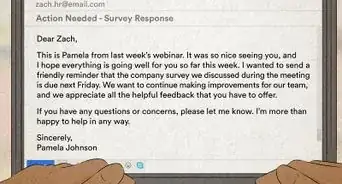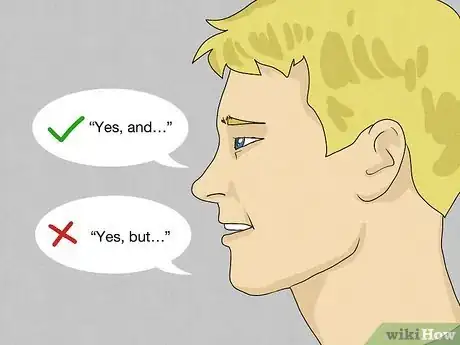This article was co-authored by Kelli Miller, LCSW, MSW. Kelli Miller is a Psychotherapist based in Los Angeles, California. Kelli specializes in individual and couples therapy focusing on relationships, depression, anxiety, sexuality, communication, parenting, and more. Kelli also facilitates groups for those struggling with alcohol and drug addiction as well as anger management groups. She is the author of “Professor Kelli’s Guide to Finding a Husband” and the award-winning and best-selling book “Thriving with ADHD”. Kelli co-hosted an advice show on LA Talk Radio and is a relationship expert for The Examiner. She received her MSW (Masters of Social Work) from the University of Pennsylvania and a BA in Sociology/Health from the University of Florida.
There are 14 references cited in this article, which can be found at the bottom of the page.
This article has been viewed 26,754 times.
There’s a fine line between defending yourself and being defensive, but it makes a world of difference between ending and escalating a problem. If you regularly find yourself justifying yourself, blaming others, or trying to distract from the problem at hand, you may be on the defense. Fortunately, if you catch yourself getting defensive, there are ways to keep things in perspective and find a solution to the problem at hand—without getting defensive about it.
Steps
Keep calm in the moment.
-
Getting angry or upset immediately tends to look defensive. If you're feeling wound up, take a deep breath, count to three, and resist the urge to say anything until you’ve had a chance to think it through.[1] X Expert Source

Psychotherapist Expert Interview. 11 June 2020. You’ll handle the situation better once you’ve had a moment to ease your tension.[2] X Trustworthy Source HelpGuide Nonprofit organization dedicated to providing free, evidence-based mental health and wellness resources. Go to source- In many situations, it’s okay to be quiet for a moment. If the other person expects a quick response, though, tell them that you need a moment: “I’m feeling a bit defensive right now and I’m taking a breath so I can respond with a level head.”[3] X Research source
- Not every conflict needs to be addressed immediately. In fact, sometimes it can help to wait a day or two so that the situation can cool down.[4] X Research source
Wait to respond to the criticism.
-
An impulsive reaction is usually based only on emotions. Your immediate reaction might be to lash out, write off the other person's feelings, or play the "blame game"— but all of these are defensive.[5] X Research source Pause for a moment before you reply, and don't interrupt or cut the other person off.[6] X Expert Source

Psychotherapist Expert Interview. 11 June 2020.- Let the person finish, even if they're wrong. Cutting in with corrections or "That's not true" shuts down further discussion.[7] X Trustworthy Source Science Magazine Respected Multidisciplinary Scientific Journal Go to source
Encourage the person to elaborate.
-
An explanation can make it clearer to you what the problem is. If you don’t understand where the criticism is coming from, or if the person said something vague, respond to them with, “Can you elaborate?” or, “Could you tell me more?”[8] X Expert Source

Psychotherapist Expert Interview. 11 June 2020. This also gives you some time to breathe so you’re less likely to respond defensively.[9] X Research source- For example, instead of, “Don’t call my design ugly. I worked hard on that,” say, “What makes you say the design is ugly?”
- If you’re worried you’ll snap at the other person, try a short statement, like, “Go on?” or “How so?”
- A direct attack is usually about some kind of frustration, not you personally. Say something like, “I can tell that something is bothering you. What’s something we can do to fix that?”[10] X Research source
Listen to what the other person says.
-
You'll be able to craft a more effective response. Chances are good that the other person is genuinely trying to help you, or is frustrated about a long-term problem. Give them the opportunity to share their thoughts and listen to what they’re telling you.[11] X Trustworthy Source HelpGuide Nonprofit organization dedicated to providing free, evidence-based mental health and wellness resources. Go to source Avoid interrupting or planning what you’ll say in response.[12] X Research source
- If you’re not sure what the other person is saying, ask for confirmation when they’ve finished. For example: “Here’s my understanding of what you just said. You feel that I’m not taking care of enough housework and you’re always asking me to do the bare minimum. Is that correct?”
- Ask the person for clarification. For example: “When you say that I’m too lenient with the kids, what do you mean by that?”
- Thank the person for telling you how they’re feeling, or for their input. Even if it’s harsh, it can show them that you’re genuinely listening.[13] X Research source
Validate the other person’s feelings.
-
You don’t need to agree with someone to make them feel heard. The other person wants to know you’re acknowledging their feedback or emotions, and if you ignore or dismiss those, you can come off as defensive or self-righteous. Validating how they feel can help them feel understood and defuse tension or frustration in the moment.[14] X Research source
- “I didn’t realize that you have to scrub the sink every time I dye my hair. I get why you’re frustrated. I would be, too.”
- “It sounds like Danica was an office legend, and that you guys miss her a lot. I imagine it’s pretty hard to not compare me to her sometimes.”
- “Your concerns about the cost are justified. I had the same thought myself—it’s expensive. Here’s what I’m considering in order to pay for it.”
Respond with the facts.
-
A factual reply is more level-headed than an emotional one. If your response is based on your emotions or opinions, you'll look more defensive than if you base your response around the facts. Leave your opinions and feelings out of your reply, and stick to what's objective.[15] X Research source
- For example, instead of “How could I steal the laptop? I wasn’t even in the room!” say, “I was in a meeting with my supervisor when the laptop was stolen.”
Use “Yes, and…” in place of “Yes, but…”
-
“But” can imply you’re trying to protect yourself somehow. What’s more, it can make the other person feel shut down, because the underlying message is “You’re wrong” or “Your side isn’t important”. If you replace “but” with “and,” though, you’ll show the other person that you want to work together and find a solution—not get defensive.[16] X Research source
- Instead of “Yes, but you yelled at me first,” try “Yes, and I don’t think yelling is constructive for either of us. I’d like us to avoid talking about politics for right now.”
- Instead of “That’s a cool idea, but I’m not sure if it’ll work,” try, “That’s a cool idea. How can we make it work?”
Use “I” statements to defuse the situation.
-
State how you feel instead of saying what they did wrong. If something specific puts you on the defense, “I” statements can be used to explain why it bothers you, without putting too much focus on the other person.[17] X Expert Source

Psychotherapist Expert Interview. 11 June 2020. An “I” statement focuses on the action, how you feel, and why it makes you feel that way: “When you do X, I feel Y, because Z.”[18] X Research source- Instead of “Quit acting like I’m stupid,” try, “When you keep asking whether I’ve ran my work through the spellchecker, I get irritated, because I feel like you see me as stupid or helpless.”
- Instead of “Stop nagging me,” try, “I feel frustrated when you keep suggesting I reach out to my mom. We have a bad relationship and I feel like you’re ignoring that.”
- Instead of “You’re not making sense,” try, “I’m not sure I understand what you’re saying.”
Offer an apology if you made a mistake.
-
It's important to take responsibility for your actions. Even if you genuinely didn't mean to do something, responding with “It was an accident” comes off as defensive, since you're not acknowledging what you did. If your actions inconvenienced or hurt someone else, then apologizing shows that you accept responsibility for what you did, even though you didn’t deliberately do it.[19] X Research source
- “You’re absolutely correct. It was my responsibility to turn in the project on time, and by not doing so, I caused the team to miss our deadline. I apologize and will stay late today so I can turn in the project by tonight.”
- “I’m sorry for sharing that article on Twitter earlier. I wasn’t aware it was racist, but that’s not an excuse. I’ve deleted it and am going to educate myself further on what racism looks like.”
- “I didn’t intend to leave you out of the party, but I see how it came across that way. I should have asked rather than assuming you’d be busy. I’m sorry.”
Apologize for your actions, not the other person’s feelings. It’s important to acknowledge your role in why they feel the way they do. Apologies like “I’m sorry you’re offended” or “I’m sorry, but you weren’t polite either” don’t show the other person that you understand why they’re upset, and can come off as dismissive.[20] X Research source
Show that you’re open to feedback.
-
Asking for feedback shows that you want to work together. You're showing that you want to improve or find a better solution, instead of proving yourself “right” and everyone else “wrong”.[21] X Trustworthy Source HelpGuide Nonprofit organization dedicated to providing free, evidence-based mental health and wellness resources. Go to source Being open to suggestions also means the other person has to give constructive feedback, so you’re focused on the solution, not each other.[22] X Trustworthy Source Science Magazine Respected Multidisciplinary Scientific Journal Go to source
- “I’m pretty surprised to hear that my work was low-quality. I believed I was following the guidelines. Can you give me some tips on what needs improvement?”
- “I don’t agree that the punishment is too harsh, but I’m open to alternatives. What do you think would be more appropriate?”
- It’s okay to challenge an unfair or bad-faith suggestion. Say something like, “Taking me off the project seems like a rather extreme response to some typos. Can you explain how that’s fair?”
Resist the urge to immediately share "your side".
-
You'll look defensive by jumping in. Even if the other person is saying things that aren't true, it won't help to interrupt, correct them, or deny what they're saying. By redirecting the discussion or saying that the person is wrong, you'll shut them down and look defensive. Let the person finish first.[23] X Research source
- Let's say someone accuses you of making an inappropriate comment towards them. Don't snap, "I never said that!" Instead, let them finish, and then ask for clarification, such as, "What comment are you referring to?"
- If you're sure the other person is wrong, keep your response factual: "I believe what you're saying. I wasn't at the event, so I don't know who said that to you."
Don't retaliate or dismiss what was said.
-
Writing someone off or lashing out is emotional and impulsive. Dismissing someone else's thoughts or feelings on something indicates you're not open to any view but your own. Similarly, verbal attacks or pinning blame on others shows that you're upset. Even if you’re angry, resist the urge to make personal attacks, ignore how the other person feels, or play the “blame game”.[24] X Research source
- "Can't you take a joke?" dismisses someone's feelings. Replace it with, "I didn't realize that would upset you. I'm sorry."
- "You're so nitpicky!" is a personal attack. Replace it with, "I hear you that the design could look better. Right now, the goal is to get it working."
Set boundaries around nonconstructive criticism.
-
You don't need to tolerate personal attacks or rude comments. If someone is being unnecessarily harsh or making it personal, you're allowed to set a boundary to keep things civil. Clearly and firmly tell the person what they need to stop doing. If they continue to do it, don't be afraid to repeat yourself or end the discussion.[25] X Research source
- "Please tell me specifically what the problem is. 'Disgusting' doesn't tell me where I need to improve."
- "If you continue to call me names, I will have to ask you to leave."
- "Do not swear at me."
Walk away if things get heated.
-
It’s tough to have a productive discussion if you’re angry or distracted. If something has really upset you or the other person, or if you’re not able to have an in-depth discussion at the moment, it’s okay to ask for a bit of time. Agree on when you’ll discuss the problem; then, take time away so that you or the other person can cool off, or so that you can handle anything pressing.[26] X Research source
- “I hear what you’re saying, but I’m really upset and need to cool down. Can we take about an hour and then come back to this?”
- “You have reasonable concerns. I still have some points to go over, so I can’t address them right now. We can discuss them together at the end of the meeting, or you and I can talk privately later.”
You Might Also Like

 33 Sweet & Romantic Apology Messages for Your Love
33 Sweet & Romantic Apology Messages for Your Love

 How Long Should I Wait to Text My Ex-Girlfriend?
How Long Should I Wait to Text My Ex-Girlfriend?
 How Long Does the No Contact Rule Take to Work?
How Long Does the No Contact Rule Take to Work?



 How to Politely Remind Someone to Reply to You
How to Politely Remind Someone to Reply to You
 What Should You Do After Your Girlfriend Lies to You?
What Should You Do After Your Girlfriend Lies to You?
 How Normal Is Fighting in a Relationship? Healthy vs. Toxic Fights
How Normal Is Fighting in a Relationship? Healthy vs. Toxic Fights


 How to Deal with Confusing People: 11 Ways to Navigate the Situation
How to Deal with Confusing People: 11 Ways to Navigate the Situation
References
- ↑ Kelli Miller, LCSW, MSW. Psychotherapist. Expert Interview. 11 June 2020.
- ↑ https://www.helpguide.org/articles/relationships-communication/effective-communication.htm
- ↑ https://ideas.ted.com/the-1-block-to-teamwork-is-defensiveness-heres-how-to-defuse-it/
- ↑ https://www.wsj.com/articles/how-to-take-criticism-well-1403046866
- ↑ https://psychcentral.com/lib/how-to-talk-to-someone-who-always-gets-defensive
- ↑ Kelli Miller, LCSW, MSW. Psychotherapist. Expert Interview. 11 June 2020.
- ↑ https://www.sciencemag.org/careers/2000/07/joy-criticism
- ↑ Kelli Miller, LCSW, MSW. Psychotherapist. Expert Interview. 11 June 2020.
- ↑ https://uwaterloo.ca/centre-for-teaching-excellence/teaching-resources/teaching-tips/assessing-student-work/grading-and-feedback/receiving-and-giving-effective-feedback
- ↑ https://ideas.ted.com/6-tips-for-dealing-with-conflict/
- ↑ https://www.helpguide.org/articles/relationships-communication/effective-communication.htm
- ↑ https://uwaterloo.ca/centre-for-teaching-excellence/teaching-resources/teaching-tips/assessing-student-work/grading-and-feedback/receiving-and-giving-effective-feedback
- ↑ https://ideas.ted.com/6-tips-for-dealing-with-conflict/
- ↑ https://psychcentral.com/health/reasons-you-and-others-invalidate-your-emotional-experience
- ↑ https://www.abc.net.au/everyday/why-we-get-defensive-and-how-to-try-a-different-approach/11295736
- ↑ https://www.abc.net.au/everyday/why-we-get-defensive-and-how-to-try-a-different-approach/11295736
- ↑ Kelli Miller, LCSW, MSW. Psychotherapist. Expert Interview. 11 June 2020.
- ↑ https://psychcentral.com/lib/how-to-talk-to-someone-who-always-gets-defensive
- ↑ https://www.cnbc.com/2019/07/15/heres-exactly-what-to-doand-sayafter-youve-made-a-mistake-at-work.html
- ↑ https://www.npr.org/2021/06/02/1002446748/youre-apologizing-all-wrong-heres-how-to-say-sorry-the-right-way
- ↑ https://www.helpguide.org/articles/relationships-communication/conflict-resolution-skills.htm
- ↑ https://www.sciencemag.org/careers/2000/07/joy-criticism
- ↑ https://www.abc.net.au/everyday/why-we-get-defensive-and-how-to-try-a-different-approach/11295736
- ↑ https://psychcentral.com/lib/how-to-talk-to-someone-who-always-gets-defensive
- ↑ https://ideas.ted.com/5-scripts-to-help-you-deflect-nosy-questions-stop-advice-givers-fend-off-criticism-and-more/
- ↑ https://www.abc.net.au/everyday/why-we-get-defensive-and-how-to-try-a-different-approach/11295736
- ↑ https://www.sciencemag.org/careers/2000/07/joy-criticism
- ↑ https://ideas.ted.com/the-1-block-to-teamwork-is-defensiveness-heres-how-to-defuse-it/
- ↑ https://ideas.ted.com/the-1-block-to-teamwork-is-defensiveness-heres-how-to-defuse-it/



























































Medical Disclaimer
The content of this article is not intended to be a substitute for professional medical advice, examination, diagnosis, or treatment. You should always contact your doctor or other qualified healthcare professional before starting, changing, or stopping any kind of health treatment.
Read More...